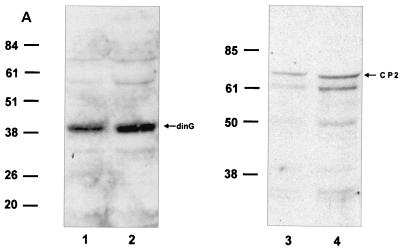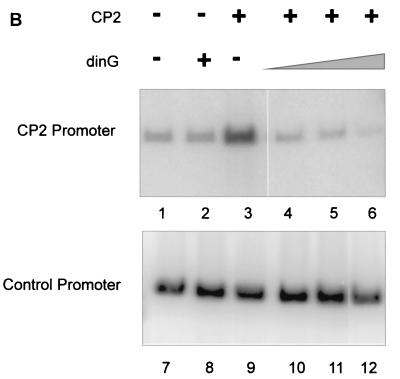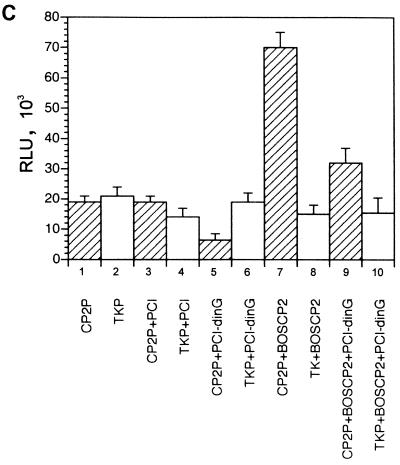FIG. 5.
dinG specifically represses CP2-dependent transcription in vitro and in a cellular context. (A) Western analysis of HeLa cell nuclear extract. Nuclear extract prepared from 5 × 107 HeLa cells was subjected to SDS-PAGE and blotted with antiserum to dinG (10 μl [lane 1] or 20 μl [lane 2]) or CP2 (10 ml [lane 3] or 20 μl [lane 4]). These antibodies display comparable affinities to recombinant protein (data not shown). The blots were developed for equal times by ECL. The migrations of the dinG and CP2 proteins and the molecular mass standards (in kilodaltons) are indicated. (B) dinG-mediated repression of CP2-dependent transcription in vitro. (Top) Crude HeLa cell extract (10 μl) was incubated with 2 nM supercoiled template DNA containing the CP2-dependent promoter in the presence of 4 mM (each) rATP, rCTP, rUTP, and rGTP. (Bottom) As an internal control, all reaction mixtures contained a 0.2 nM concentration of a template containing the AdML promoter. Recombinant CP2 (20 ng) or dinG (20 to 200 ng) was added to the reaction mixtures as indicated. Transcription assay mixtures were incubated for 30 min at 30°C. RNA synthesized in vitro was analyzed by primer extension. (C) dinG-mediated repression of CP2-dependent transcription in a cellular context. 293 cells were transiently transfected with a CP2-dependent promoter linked to the luciferase reporter gene (hatched columns) and the TK promoter linked to the Renilla luciferase reporter gene (open columns) in the presence or absence of a dinG expression vector (PCI-dinG) and a CP2 expression vector (pEFBOS-CP2) as indicated. Transfection with the empty vector (pCI) served as the control. Luciferase levels were corrected for protein concentration, and values were derived from three independent experiments performed in triplicate.



